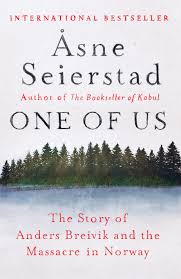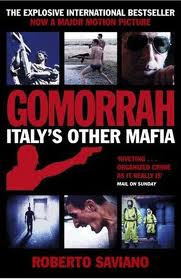
Virago Press (2015 – first published 2013), 544 pages
It’s been ages since I posted any reviews. I’ve been very busy with work and a few other things that have taken up my time/tired me out! Hopefully I’ll manage to post a bit more regularly in the coming months.
One of Us: The Story of Anders Breivik and the Massacre in Norway is a story about evil. Seierstad traces Breivik’s life from his birth to his horrific crimes, his trial, and eventual (almost certainly lifelong) incarceration. Seierstad’s book is a forensic inquiry into the nature of evil; was Breivik born evil or did his circumstances make him evil? In the end this doesn’t matter to Breivik’s victims. Breivik killed seventy seven of his fellow citizens in an attempt to further his twisted ideology. Seierstad goes to great lengths to humanise Breivik’s victims, they are not simply numbers. As Seierstad explores Breivik’s life she also traces the lives of a number of his victims, until their fateful meeting. Although it was Breivik’s narcissism, personal issues (including unstable sexuality and failed business ventures), and desire to prove himself to the world that were causes of his crimes, the exact reasons why one person will suffer their inner demons and another person will explode in violence remain a mystery.
Breivik’s early childhood was painful. His mother Wenche was mentally unstable and unable to provide stability to him or his sister Elisabeth. His father was largely absent from his son’s life. When he was involved he seemed to be overly harsh almost as if he was looking for an excuse to cut his son out of his life.
Breivik’s sexuality was confused to put it mildly. Wenche seems to have had sexual issues herself, neighbours commented on her inappropriate sex talk. As Wenche struggled to cope with Breivik it was agreed that he would be put into care for two weekends a month. On the second weekend Wenche asked (when Breivik was aged 2) if he could occasionally touch his weekend dad’s penis as he only had contact with females. He struggled to connect with real women, he seemed more at home with images of women. He met a woman from Belarus online using a “mail order bride” service. Breivik, as was seen more explicitly in coming years, was a mysoginist. If he felt any desires for a women at all he wanted his version of a traditional wife, an obedient female to cook the dinner and obey him. His presumptive bride, Natascha, was the first woman he had brought home to his mother. Unfortunately Natascha didn’t live up to expectations. She wanted to go shopping and wasn’t happy with Breivik’s chauvinism. There were no more girlfriends in Breivik’s life.

Breivik failed to read social signals correctly. He struggled to connect with his peers. In school he was a lower order bully who dreamed of being cool. He became a middle ranking tagger, spraying graffiti around Oslo. However he struggled to know his place, always feeling he was higher up the pecking order than he really was. He was tolerated but seen as slightly naff, slightly off-key, he tried too hard, pushed too far, became seriously uncool, and was excluded from tagging circles. Tagging was also the cause of his final break from his father. Incredibly, after a third arrest for tagging, his father broke off all contact with the 15 year old. He joined the right-wing Progress Party but failed to be selected as a candidate for them. Again he overstepped the mark, thinking he was more more important than he was. It was not that Breivik had no friends, he even had some immigrant friends in childhood, but it seems as if any time he encountered failure he dropped any friends associated with the time. His attempts to become wealthy in business by running a company selling fake degrees came to an end when the police started to take an interest. His attempts to make money from trading stocks on the internet didn’t work out. The Freemasons were not what he thought it would be and he rarely attended meetings.
Breivik’s life disappointments could be defined as failures but they are not so different from the occasional life disappointments faced by many people. However Breivik was a narcissist. He did not develop the normal social support network of family and friends. He felt himself superior to everybody he encountered, more intelligent, better looking, physically excellent. He played no part in his life’s downturns, these were entirely other people’s fault. He sunk into a life of playing video games in his mother’s flat. He built a network he could control, an online network, that further distanced himself from normal human relations and was based around simulated violence. When he emerged from this cocoon he had decided on his course of action. He rented a farm, built bombs, gathered weapons, and launched his deluded attacks in Oslo and against unarmed children and teenagers on Utøya island. Seierstad points out the numerous security failings around government buildings and failed opportunities to stop Breivik before he reached the island. Seierstad goes through Breivik’s killings in detail. I couldn’t read it all. Seierstad looked at the full and varied lives of several of Breivik’s victims – you get to know them as you read the book. Their lives have the ordinary beauty of many of our lives but the hopes and dreams of the victims are cast into sharp relief by Breivik’s murderous actions.
Breivik’s psychopathic narcissism is quickly demonstrated to police shortly after his arrest. He complains about a small cut on his finger. After murdering dozens of people he is concerned about a tiny cut on his finger. Breivik has never, nor never will, show any remorse for his victims. He will never be released from prison. His dreams of starting a far right revolution across Europe have never materialised. The effects of imprisonment have begun to take their toll. Despite his best efforts he is perhaps slowly realising that he is not the centre of attention for the world. He is fading from view. His recent successful case against his prison conditions is a sign that he is desperately taking every opportunity to place himself centre stage. Breivik will die unloved (except perhaps by his mother). Breivik’s victims’ lives and deaths continue to have a greater impact on the world than Breivik’s depraved acts.
9/10
Related Links

